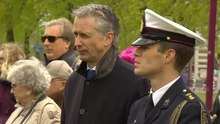Vrouwen van Ravensbrück
Vrouwen van Ravensbrück ( German Women of Ravensbrück ) is a memorial in the east of the central Amsterdam Museumplein , which is intended to commemorate the people who were murdered and perished in the National Socialist concentration camp Ravensbrück . Inaugurated on April 25, 1975, the monument was designed by the artist Joost van Santen and with the collaboration of the artists Frank Nix and Guido Eckhardt on behalf of the municipality of Amsterdam and the “Comité Vrouwen van Ravensbrück”.
layout
The memorial consists of eleven rectangular steles made of stainless steel, which are bedded on natural stone and are arranged in a semicircle around a central column. With a height of 3.40 m, the central column is also the largest element of the installation, which apart from this is around 9 m wide and 7.50 m deep.
The memorial contains light and sound elements: the middle column sends out pulsating, cold-white light rays through narrow slits, which are reflected by the metal elements surrounding it in a semicircle and symbolize the searchlights of the concentration camp; they remind of the women who did not survive Ravensbrück. In addition, a heartbeat-like sound dedicated to the survivors can be heard when entering the natural stone foundation and when approaching. When the highest brightness is reached, the light beam and the palpitation of the heart stay away for a moment, creating a moment of silence.
The second and third stela from the right are inscribed; below the analogous German translation:
“Vrouwen van ravensbrück 1940–1945: voor hair die dead het uiterste neen bleven zeggen tegen het fascisme”
"Women from Ravensbrück 1940–1945: For them who stood up to the extreme against fascism."
Another inscription was added in 2002; below again the analogous German translation:
“The nagedachtenis aan de 90,000 vrouwen en kinderen en de 20,000 men brought into het concentration camp Ravensbrück zijn om.”
"In memory of the 90,000 women and children and the 20,000 men who were killed in the Ravensbrück concentration camp."
The monument was originally erected in the west of the square, near the Van Gogh Museum. In the course of the redesign of the Museumplein in 1996 and the expansion of the Van Gogh Museum, the monument was moved to the eastern edge of the square.
Memorial event
A commemorative event is held every year to mark the liberation of the Ravensbrück concentration camp. In 2017, the then Dutch Defense Minister Jeanine Hennis-Plasschaert took part in this event; Her great-grandmother had hid people in hiding in her house and after the denunciation she was also one of the people interned in Ravensbrück. In her speech, Hennis referred to the hope that the women of Ravensbrück gave to one another.
Web links
Individual evidence
- ↑ De opdracht. In: Stichting Comité Vrouwenconcentratiekamp Ravensbrück. Retrieved April 30, 2019 (Dutch).
- ↑ a b Monument voor Vrouwen van Ravensbrück. In: kunst en publieke ruimte. Archived from the original on October 20, 2017 ; Retrieved April 30, 2019 (Dutch).
- ^ Vrouwen van Ravensbrück. In: buitenbeeldinbeeld.nl. Retrieved May 1, 2019 (Dutch).
- ↑ 'Amsterdam, Vrouwen van Ravensbrück'. In: Nationaal Comité 4 en 5 mei. Retrieved April 30, 2019 (Dutch).
- ↑ Herdenkingen: Vrouwen van Ravensbrück en oorlogsslachtoffers Nieuwmarkt. In: Nationaal Comité 4 en 5 mei. Retrieved April 30, 2019 (Dutch).
- ↑ Vrouwen van kamp Ravensbrück herd. In: De Telegraaf. April 23, 2017, accessed May 1, 2019 (Dutch).
Coordinates: 52 ° 21 '25 " N , 4 ° 52' 56" E


